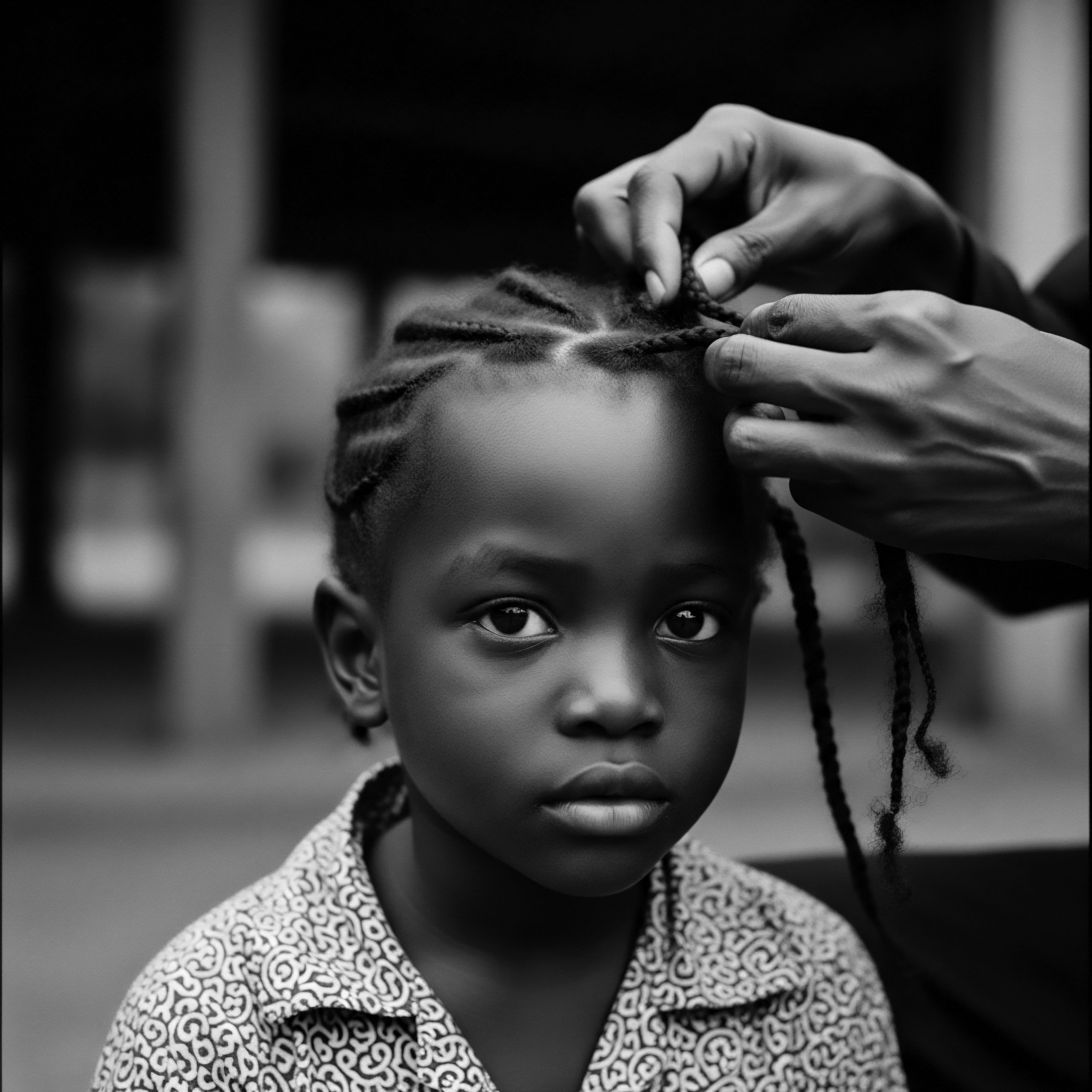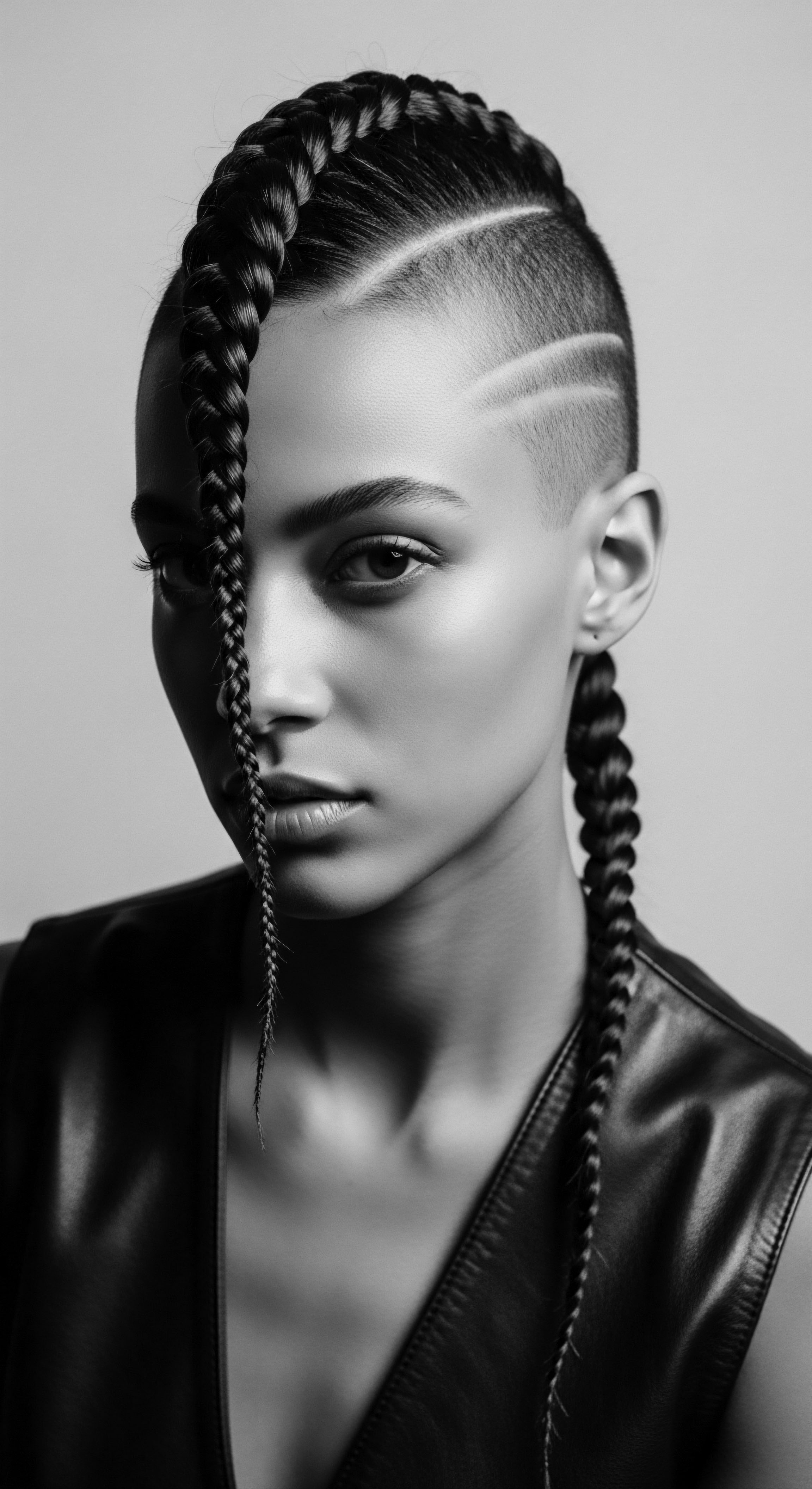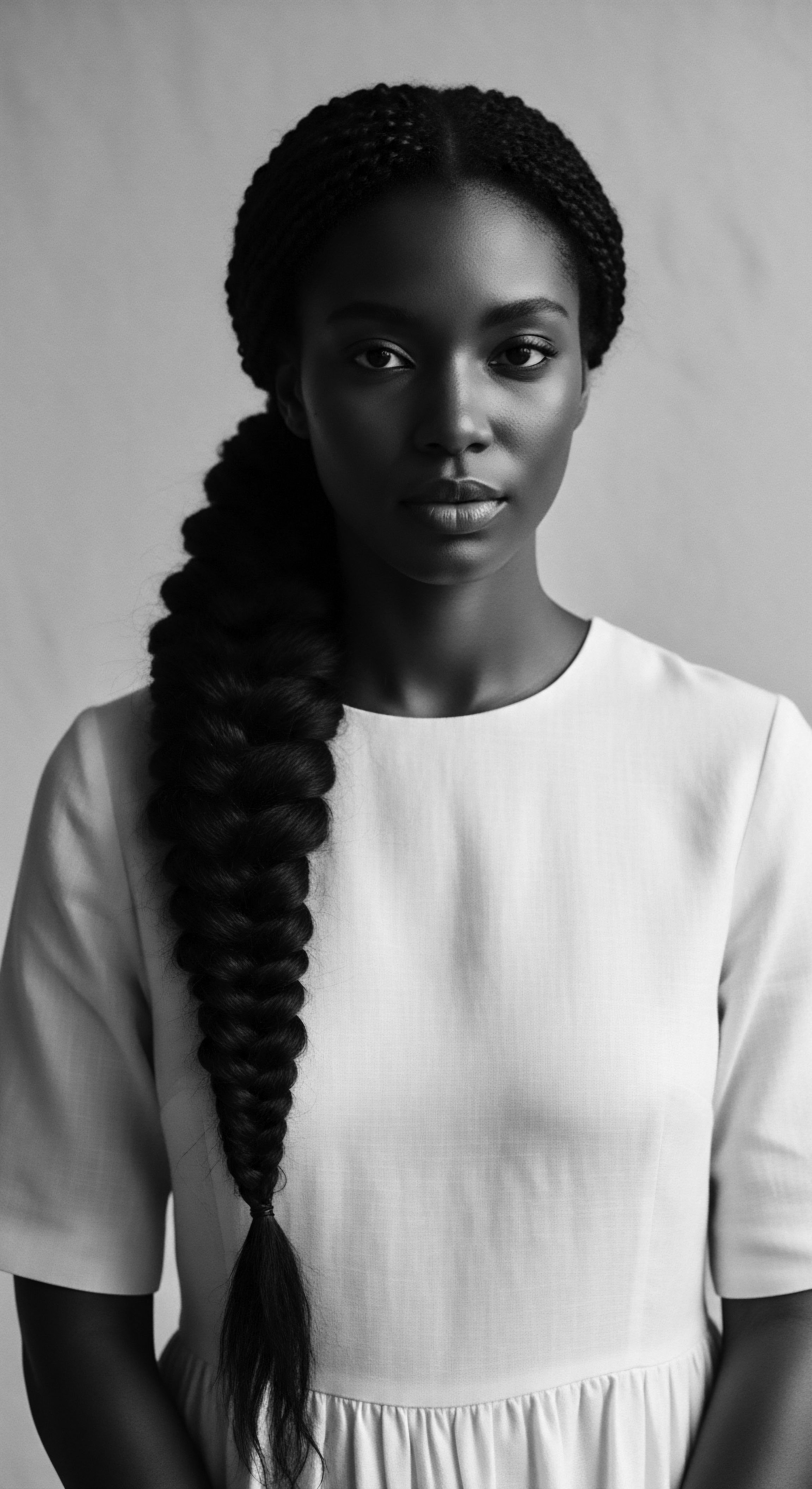
Roots
Across the vast, undulating landscapes of time, before the shadowed ships traversed the wide ocean, textured hair stood as a crown, a testament to belonging, to spirit, to lineage. It held stories within its very coil, a living record of kinship, ceremony, and the natural world. Then came the era of enslavement, a fracturing force that sought to sever every tie to the ancestral soil, to fragment memory, to dim the light of selfhood. Yet, within this crucible of unimaginable suffering, the ancient practices of hair care, those whispers carried from distant lands, adapted, transformed, and held steadfast, becoming an unspoken language of survival and persistent heritage .
The resilience of textured hair, in its very structure, mirrored the unyielding spirit of those who bore it. From the elemental biology of the strands themselves, coiled and deeply porous, arose specific needs that ancestral wisdom had long addressed. The very architecture of a curl, its helical path, often meant that the scalp’s natural oils struggled to descend its length, leaving the ends dry, prone to breakage.
This inherent characteristic, understood through generations of observation in West and Central Africa, laid the groundwork for care rituals centered on oiling, moisturizing, and protective styling. When forcibly removed from their homes, individuals carried this intimate understanding, not in books or written scrolls, but woven into the very fabric of their beings, a knowledge passed through touch, observation, and necessity.
The fundamental nature of textured hair, its unique biology, formed the initial blueprint for care, a wisdom carried across oceans through generational memory.

The Unyielding Strand
What indeed comprises the fundamental understanding of textured hair from a historical and scientific heritage perspective, especially as it faced the extreme duress of enslavement? Textured hair, distinct in its varied curl patterns—from broad waves to tightly wound coils—possesses a unique elliptical cross-section, unlike the rounder, more symmetrical cross-sections found in straight hair. This structural difference, a legacy of millennia, contributes to its remarkable volume and strength, yet it also presents particular challenges.
The cuticle layers, which serve as the hair’s protective outer shell, are often more lifted in highly coiled textures, making the hair more susceptible to moisture loss and tangles. Scientific study now corroborates what ancestral practitioners knew intrinsically ❉ hydration and gentle handling are paramount for these delicate, yet mighty, fibers.
- Elliptical Follicle Shape ❉ Contributes to the unique curl pattern and tensile strength, a distinct ancestral marker.
- Lifted Cuticle Layers ❉ Predisposes textured hair to moisture loss, highlighting the traditional emphasis on emollients.
- Uneven Sebum Distribution ❉ Natural oils from the scalp struggle to travel down the coiled shaft, necessitating external moisturizing methods from antiquity.

How Did Ancestral Understanding of Hair Anatomy Influence Adaptations?
Ancestral understanding, passed down through the ages, was deeply empirical, rooted in keen observation of the natural world and the body. Before the trauma of forced migration, communities developed sophisticated methods tailored to their specific hair types, using readily available botanicals and animal products. The knowledge of which plant-based oils penetrated best, which clays clarified without stripping, or which herbs conditioned deeply, formed a vibrant lexicon of hair care. This lexicon, though stripped of its original context in the new world, became a vital, secret language.
For instance, the use of shea butter (Vitellaria paradoxa), indigenous to West Africa, or palm oil (Elaeis guineensis), was not merely cosmetic; it was a deeply informed response to the hair’s inherent need for rich, occlusive moisture, creating a protective barrier against harsh environmental conditions. The forced removal meant a loss of these specific, geographically tied ingredients, yet the principle of their use—the need for profound hydration and protection—persisted. This fundamental understanding of hair’s elemental biology, an echo from the source, became the silent guide for adaptation under brutal circumstances.

Ritual
The ritual of hair care, under the grinding wheels of enslavement, underwent a profound metamorphosis. What had once been a vibrant communal activity, celebrated with song, storytelling, and intricate artistry in one’s homeland, transformed into a clandestine act, often performed in stolen moments, behind the veil of night, or in hushed gatherings. Yet, despite the oppressive conditions, these moments of care were not merely about hygiene; they became profound expressions of selfhood, resistance, and the continuity of ancestral ways. They were acts of reclamation in a system designed for dehumanization.
The hands that once braided intricate patterns for ceremonies and social markers now found new purpose, meticulously tending to hair under the gaze of oppression. These hands, scarred by labor, became conduits for memory, for solace, and for a quiet rebellion. Women, in particular, often became the custodians of this knowledge, sharing what they remembered, improvising with what little they had.
The very act of combing another’s hair, of detangling, of styling, forged bonds that transcended the brutality of their daily existence. This was the true art and science of textured hair styling adapting; it was a testament to the enduring power of human connection and cultural transmission even under dire constraints.
Hair care rituals, though stripped of their original grandeur, persisted as acts of quiet defiance and profound communal bonding amidst the horrors of enslavement.

How Did Hair Styling Methods Adapt to Scarcity and Suppression?
The stylistic adaptations of textured hair during enslavement were born of stark necessity, limited resources, and the persistent human desire for dignity. Many individuals found themselves without access to traditional tools or familiar ingredients. The elaborate hair combs fashioned from wood or bone, the decorative pins, and the wide array of natural dyes and emollients used in their homelands were largely absent. Ingenuity became the new currency.
Crude tools were fashioned from whatever was available ❉ animal bones, pieces of wood, or even discarded metal. The very fingers became the primary implements for detangling, twisting, and coiling.
Protective styles, a cornerstone of ancestral textured hair care, took on renewed importance. These styles shielded delicate strands from the harsh sun, the abrasive fabrics of forced labor, and the general neglect that life as an enslaved person often entailed. Braids, twists, and knots, which had deep cultural significance as markers of status, age, or tribal affiliation in Africa, became practical solutions for managing hair that could not be washed or tended to regularly. Moreover, these styles could be undone and redone with minimal effort, requiring less water and fewer specialized products.
| Ancestral Practice Elaborate Braiding Patterns (Status Markers) |
| Adaptation During Enslavement Simpler, Tightly Woven Braids (Durability, concealment of messages) |
| Heritage Significance Maintenance of hair health; covert communication pathways; connection to cultural aesthetics. |
| Ancestral Practice Use of Specific Natural Emollients (Shea, Palm Oils) |
| Adaptation During Enslavement Improvised Conditioners (Animal fats, leftover cooking oils) |
| Heritage Significance Sustained hydration; protection against breakage; preservation of hair texture. |
| Ancestral Practice Ornate Combs and Hairpins |
| Adaptation During Enslavement Fingers, Crude Implements (Wood splinters, metal scraps) |
| Heritage Significance Necessity as the mother of invention; emphasis on manual dexterity; perpetuation of care habits. |
| Ancestral Practice Community Hairdressing Rituals |
| Adaptation During Enslavement Hushed, Secretive Grooming Sessions |
| Heritage Significance Continued social bonding; shared knowledge transfer; acts of quiet resistance. |
| Ancestral Practice These adaptations underscore the remarkable ingenuity and enduring spirit of cultural retention among enslaved populations. |

How Were Tools and Materials Improvised for Care?
The ingenuity of enslaved individuals in improvising tools and materials for hair care speaks powerfully to their resilience and resourcefulness. Without access to traditional African combs crafted from specialized woods or ivories, people turned to whatever remnants they could find. A sharpened bone, a sturdy stick, or even pieces of metal scrap could become a rudimentary comb for detangling. For cleansing, harsh lye soaps, designed for general cleaning, might have been the only option, yet individuals would have sought to soften their effects with what little natural conditioning agents they could procure.
The scarcity of natural ingredients, like the rich butters and oils native to Africa, forced a reliance on what was locally available or even discarded. Animal fats rendered from hogs or cows became substitutes for more refined emollients. Castor beans, once processed, yielded an oil that provided significant moisture, a practice that survives in parts of the diaspora to this day. Clays, sometimes collected from riverbanks, might have served as cleansing or conditioning agents.
These makeshift remedies were not simply about managing hair; they were about maintaining a connection to a deeper tradition of self-care, a profound acknowledgement of one’s body and spirit even when one’s autonomy was denied. The adaptations were not merely functional; they were infused with the spirit of survival and the yearning for dignity.

Relay
The relay of knowledge, that delicate yet robust chain of ancestral wisdom, faced its ultimate test during the era of enslavement. It was a time when formal transmission was brutally suppressed, when families were torn asunder, and when the very continuity of cultural practices hung by the slenderest of threads. Yet, the deep understanding of textured hair care, steeped in generations of heritage, found a way to persist, often through unspoken lessons, through observation, and through the quiet, consistent acts of care passed from elder to youth, from mother to child, from one weary soul to another. This relay was not merely about teaching techniques; it was about transmitting identity, worth, and the enduring power of a shared past.
This period saw the blending of what was remembered from diverse African traditions with the meager, often harsh, realities of the New World. It was a dynamic process of adaptation, where knowledge was not static but continually refined and reinterpreted. The traditional practices, rooted in ancestral wellness philosophies, had to be reimagined.
The holistic connection between inner wellbeing and outer presentation, a cornerstone of many African worldviews, remained, even if its outward expression was constrained. The very act of tending to one’s hair, or another’s, became a quiet defiance, a reaffirmation of personhood that the system sought to crush.
Despite deliberate suppression, the profound heritage of textured hair care was relayed through improvised means, often as a silent, yet powerful, act of cultural continuity.

How Did Cultural Philosophies of Hair and Self Adapt Under Enslavement?
The cultural philosophies surrounding hair, which in many African societies embodied spiritual significance, social status, and communal identity, underwent profound adaptation. In their homelands, hair was often seen as a conduit to the divine, a locus of spiritual energy, or a visual representation of one’s lineage and standing. Specific styles communicated marital status, age, or profession. When individuals were stripped of their names, their families, and their very autonomy, the ability to express these intricate cultural meanings through hair was severely curtailed.
The imposed conditions of servitude often demanded conformity, practicality, and the suppression of any expression that might signify autonomy or rebellion. Head coverings, for instance, were frequently mandated, effectively erasing visible signs of cultural identity and beauty, and acting as a tool of dehumanization.
However, even beneath these enforced coverings, or in the brief respites from labor, the internal philosophy persisted. The meaning shifted, perhaps, from overt cultural declaration to a deeper, more private act of self-preservation and memory. A woman might still braid her hair in a specific pattern, not for public recognition, but for the quiet comfort of continuity, for the internal connection to her grandmother’s hands or the traditions of her distant village.
The act of washing, oiling, and braiding became a form of psychological survival, a small corner of existence where selfhood could still be asserted. In this sense, the adaptation was not merely physical, but spiritual, where the inner meaning of hair as a part of the self remained, even if its outward cultural expression was muted or transformed into a silent, shared code.
One potent, albeit tragic, example of adaptive knowledge transfer and its profound connection to resistance is documented in narratives and historical accounts. For centuries, various West and Central African societies utilized intricate hair braiding patterns not merely for aesthetic or social purposes, but as a sophisticated means of communication and a practical method for survival. During the era of enslavement, this practice took on a covert yet vital role.
For example, some historical accounts and oral traditions suggest that enslaved people, particularly women, would braid maps into their hair , indicating escape routes, places to hide, or meeting points for those planning to flee. These “freedom braids” or “cornrow maps” were not just practical instructions; they were a testament to the ingeniousness of cultural adaptation under duression.
Moreover, seeds, rice, or other small grains were sometimes woven into these elaborate styles, providing sustenance for long journeys or planting material upon reaching freedom. This practice, while not universally documented across all plantations or communities, represents a powerful fusion of practical survival skills with deeply embedded cultural knowledge of hair as a canvas for meaning. It illustrates how ancestral practices, normally associated with beauty or social signaling, could be transformed into tools of liberation, profoundly demonstrating the adaptive nature of textured hair care within a context of systemic oppression.
(Roberts, 2003, p. 57) This specific historical instance highlights how the very act of hair styling transcended mere appearance, becoming a vehicle for hope and a silent, dangerous act of rebellion.
- Map Braids ❉ Intricate cornrow patterns sometimes served as literal guides for escape routes, their twists and turns mirroring trails and rivers.
- Seed Concealment ❉ Small seeds and grains were reportedly braided into hair, providing sustenance or future crops for those seeking freedom.
- Symbolic Styles ❉ Certain knots or partings, while appearing innocuous, might have conveyed coded messages or acted as signals within the enslaved community.

How Did Enslavement Alter Hair Growth Cycles and Scalp Health?
The brutal conditions of enslavement had profound, detrimental effects on hair growth cycles and overall scalp health. Chronic stress, a constant companion for enslaved individuals, significantly impacts the body’s physiological processes, including hair growth. Elevated cortisol levels, poor nutrition, constant physical exertion, and inadequate hygiene led to widespread health issues.
Malnutrition, specifically deficiencies in essential vitamins, minerals, and proteins, directly impairs the hair follicle’s ability to produce healthy strands, leading to thinning, breakage, and stunted growth. The average lifespan of a hair strand might have been shortened, and the density of hair could have diminished.
Furthermore, harsh working conditions and lack of proper bathing facilities often resulted in poor scalp hygiene. Exposure to elements without protection, coupled with limited access to clean water and gentle cleansing agents, contributed to scalp infections, inflammation, and parasitic infestations. These conditions created an environment hostile to healthy hair growth, often leading to issues like traction alopecia from tightly bound styles, or fungal infections exacerbated by communal living and lack of sterile practices.
Yet, despite these overwhelming challenges, the dedication to hair care persisted, a testament to the deeply rooted ancestral belief in the sanctity of the self. The adapted regimen of care became less about achieving ideal beauty and more about maintaining basic health and dignity against tremendous odds.

Reflection
The legacy of textured hair care during the era of enslavement is not merely a historical footnote; it is a resonant chord in the collective memory, a profound testament to human spirit and cultural tenacity. It reminds us that even when stripped of agency, dignity, and every earthly possession, the inner world, the spirit’s connection to its past, finds pathways to endure. The adaptations in hair care—from improvising tools and ingredients to embedding coded messages within braids—speak volumes about the ingenuity and unwavering spirit of those who navigated unspeakable cruelty.
Today, as we engage with our textured strands, perhaps selecting a rich butter or opting for a protective style, we are not simply tending to our physical selves. We are, in a very real sense, participating in a living library of ancestral wisdom. Each twist, each braid, each application of oil carries an echo of those who came before, who, under the most trying circumstances, insisted on the right to care for their hair, to see themselves, to retain a piece of their identity. The journey of textured hair care from the elemental biology of the strand, through the tender thread of communal practices, to its role in voicing identity, culminates in an unbound helix of heritage.
It is a story of survival, of reclamation, and of the luminous beauty that continues to rise from the depths of history. This journey, this deep connection, reminds us that our strands are not just protein and pigment; they are vessels of memory, vibrant archives of a heritage that refused to be extinguished.

References
- Roberts, Robin. (2003). Hair in African Art and Culture. Museum for African Art.
- Walker, Alice. (2001). The Temple of My Familiar. Harvest Books.
- Hooks, Bell. (1995). Art on My Mind ❉ Visual Politics. The New Press.
- White, Deborah Gray. (1999). Ar’n’t I a Woman? ❉ Female Slaves in the Plantation South. W. W. Norton & Company.
- Byrd, Ayana D. and Lori L. Tharps. (2014). Hair Story ❉ Untangling the Roots of Black Hair in America. St. Martin’s Press.
- Rappaport, Joanne. (2009). The Disappearance of the Arawak Indians ❉ A Historical and Cultural Perspective. Cambridge University Press.
